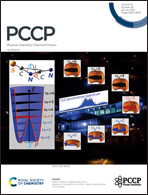Wave function analyses of scandium-doped aluminium clusters, AlnSc (n = 1–24), and their CO2 fixation abilities†
Abstract
Nanoclusters represent a connection between (i) solid state systems and (ii) species in the atomic and molecular domains. Additionally, nanoclusters can also have very interesting electronic, optical and magnetic properties. For example, some aluminium clusters behave as superatoms and the doping of these clusters might strengthen their adsorption capabilities. Thus, we address herein the structural, energetic and electronic characterisation of scandium-doped aluminium clusters (AlnSc (n = 1–24)) by means of density functional theory calculations and quantum chemical topology wave function analyses. We studied the effect of Sc-doping on the structure and charge distribution by considering pure Al clusters as well. The quantum theory of atoms in molecules (QTAIM) reveals that interior Al atoms have large negative atomic charges (≈2a.u.) and hence the atoms surrounding them are considerably electron deficient. The Interacting Quantum Atoms (IQA) energy partition allowed us to establish the nature of the interaction between the Al13 superatom and the Al12Sc cluster with Al to form the complexes Al14 and Al13Sc, respectively. We also used the IQA approach to examine (i) the influence of Sc on the geometry of the AlnSc complexes along with (ii) the cooperative effects in the binding of AlnSc and Aln+1 clusters. We also exploited the QTAIM and IQA approaches to study the interaction of the electrophilic surface of the examined systems with CO2. Overall, we observe that the investigated Sc-doped Al complexes with a marked stability towards disproportionation reactions exhibit strong adsorption energies with CO2. Concomitantly, the carbon dioxide molecule is considerably distorted and destabilised, conditions which might prepare it for further chemical reactions. Altogether, this paper gives valuable insights on the tuning of the properties of metallic clusters for their design and exploitation in custom-made materials.



 Please wait while we load your content...
Please wait while we load your content...